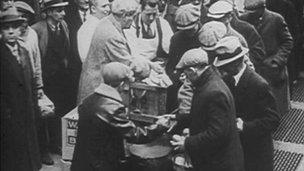Leeds food demand 'above 1930s Depression era levels'
- Published

St George's Crypt was formed in the 1930s when 80 people a day used to queue for food
Demand for food and shelter in Leeds is at a higher level than during the Great Depression era of the 1930s, a homeless charity has claimed.
When it formed in the 1930s, St George's Crypt used to feed 80 people a day. Now that figure has risen to 100, the charity said.
It cites job losses and the recession as the main reasons for the rise.
The Department for Work and Pensions said it was "committed" to supporting households on low incomes.
Chris Fields, chief executive officer of St George's Crypt, said the charity used to feed an average of 60 people a day before the credit crunch in 2006.
He said demand for food and shelter had now reached "an all time high that we've never seen before".
'Dire situations'
"Where we used to get people who were always homeless, we're now finding people who were in full-time employment coming through," said Mr Fields.
"With the benefit cuts, the credit crunch and joblessness, they're finding themselves in terrible, dire situations where they're having to come to a homeless shelter."
Builder Simon Fletcher worked on the extension of the charity's centre three years ago. Now, out of work, he is one of the many accessing its services.
He said: "You've worked all your life and then suddenly there is no work. I never thought I'd be in a situation like this."
St George's Crypt sees more than 50 people a week requesting emergency accommodation at its 15-bed city centre hostel, which is currently oversubscribed, the charity said.
The surge in food demand has prompted the charity to establish a foodbank, which is expected to open in October.
Department for Work and Pensions said it was "committed to supporting households, particularly those on low incomes" and had a dedicated employment programme to help unemployed people get back into work.